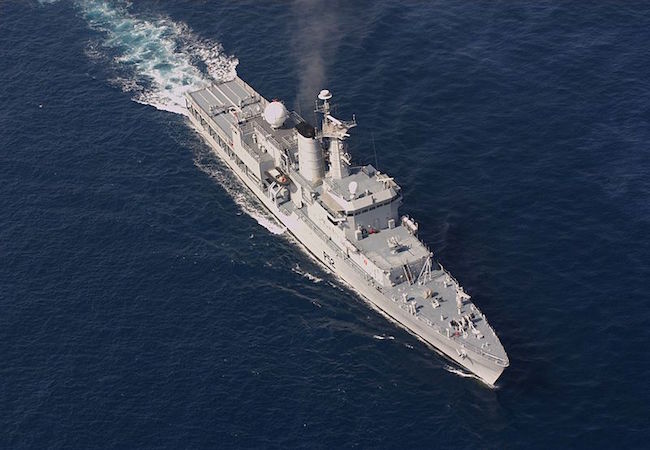Expansion of Indian Naval Forces in the Indian Ocean

By Beenesh Ansari
The decade beginning the year 2010 has seen some rapid growing military initiatives around the globe, especially in South Asia and Middle East Asia, where the land and air forces of the countries have been strictly occupied with direct and indirect tactical conflicts among themselves. The Indian Naval Forces have taken a more strategic role in controlling the events of the international waters of Indian Ocean. With the passage of time and developing global economies, many states strategic thinking is focused on the Indian Ocean.
The Indian Ocean is harboring a sizeable share in supporting the international trade routes, with almost 40% of the world’s oil trade being carried out through these waters. 95% of India’s own international trade is carried out through Indian Ocean that includes imports of crude oil to meet 83% of its requirements. The Indian government, especially the ruling party of BJP has made untiring efforts in redefining its political ties with the countries sharing its sea on the Indian Ocean. The highlights of these ties require the mention of the strategic pact with France and United States signed in recent years to offer the Naval bases to harbor warships of one another. The Port of Djibouti holding the most important strategic value to India and China.
The Indian Naval Fleet has reached the size of 140 warships and increasing, the planned induction of 56 more warships and 6 submarines is underway. Emphasizing the importance of Indian Navy Submarine program, the Indian Naval Chief Admiral Sunil Lanba had said that after the successful induction of the first Scorpene submarine of India, INS Kalvari, in December 2017, several trials have been conducted by India on its second Scorpene class attack submarine INS Khanderiin the seas, and is ready to commission it. The ambition of the Indian Naval Chief was to bring up this number to 200 warships and 500 aircraft in the Indian Naval Force. Other than all these increase in the naval capabilities at sea, in October, 2018 India signed a contract with Russia worth $950 million for buying “two stealth frigates”. India has planned to increase its naval arsenal by 212 warships and 458 Naval aircraft, compared to just 138 and 235 at present.
The desire for naval supremacy in the Indian Ocean has no longer remained a thrive for military dominance anymore, at least not for the Indian Ocean. The Indian Navy expanding its resources and firepower in the sea zone is targeted to achieve control over the seas, rather than a military doctrine of enemy denial. Simply put, India is aiming to safeguard its merchant ships to easily navigate in the waters to carry out the trade routes for its business and commercial purposes, all the while, ensuring denial of the trade routes for its enemies. But for that to happen, India has to strive for a much larger Navy and strategic pacts and partnerships for more allies among the littoral countries in the Indian Ocean. In June 2019, Indian navy expanded its naval presence especially after the shot down of the US drone by Iran, flying over Strait of Hormuz, as according to Iran, it violated their airspace. To ensure Indian flagged vessels in the Indian Ocean Region, its navy deployed several warships in the Persian Gulf as well as the Gulf of Oman.
The ultimate goal for India at the moment is to deny trade to China. These endeavors of India to gain control of waters and trade routes in the Indian Ocean can only be reckoned to affect the majority trade controlling Asian country. With its trade routes being developed and established in the region, and the Belt and Road Initiative (BRI), China is set to mark its dominance in the regional trade routes of Asia and Indian Ocean. China is by far, more superior in terms of its land, air, and sea forces. Moreover, China is making investments in the projects for development of ports to be able to avail access for the fulfillment of its economic goals. India cannot contain China alone, so with the help of states like US and Japan, it is working towards building its naval military in the region.
Ramping up military modernization and expanding its naval capabilities are part of India’s push to assert itself as the region’s dominant power. Though the country’s political experts club these moves as part of the measures being taken to safeguard their security interests, against the growing Chinese influence in the region. However, objective analysis would reveal that the projection of China as a threat in the Indian Ocean region has often been exaggerated. India also tried to intrude Pakistan’s sovereignty through sea channels.
What seems from all these developments is that India is eager to expand its ambit of influence in Indian Ocean by giving its navy a blue water capability and to counter Chinese influence in IOR with help of US. However, the current geo-political scenario of the South Asian region, which is centered around India, is consuming large chunks of its land military forces. The dispute of India and China over the Line of Actual Control, India’s bitter relations with Pakistan, constant Line of Control (LOC) violations and the latest Kashmir Lockdown as left India in no shape to proceed with the expansion of its sea forces until the current issues are resolved. Accidents attacks or potential conflict involving nuclear submarines, is an environmental challenge let alone the security challenge in the Indian Ocean. In the backdrop of traditional enmity, adding to the Indian Naval advancements of Indian Navy fleet of the “nuclear capable submarines” poses a serious threat to Pakistan and China. The international community seems reluctant in pressurizing India to halt its naval expansions. As, such immature provocation will not only mitigate threat but also encourage other states to advance their nuclear naval capabilities, resulting in a constant arms race in the region. Not to forget, the naval conflicts have grave effects on the regional mainland politics.
Beenesh Ansari is a Senior Research Fellow at South Asian Strategic Stability Institute. She completed her M.Phil, International Relations in 2017. Her area of interest includes Pak-China Bilateral Relations, Indian Ocean Security Situation, Strategic Stability in South Asia, Geo-politics in Middle East and Global Refugee Crises etc.







